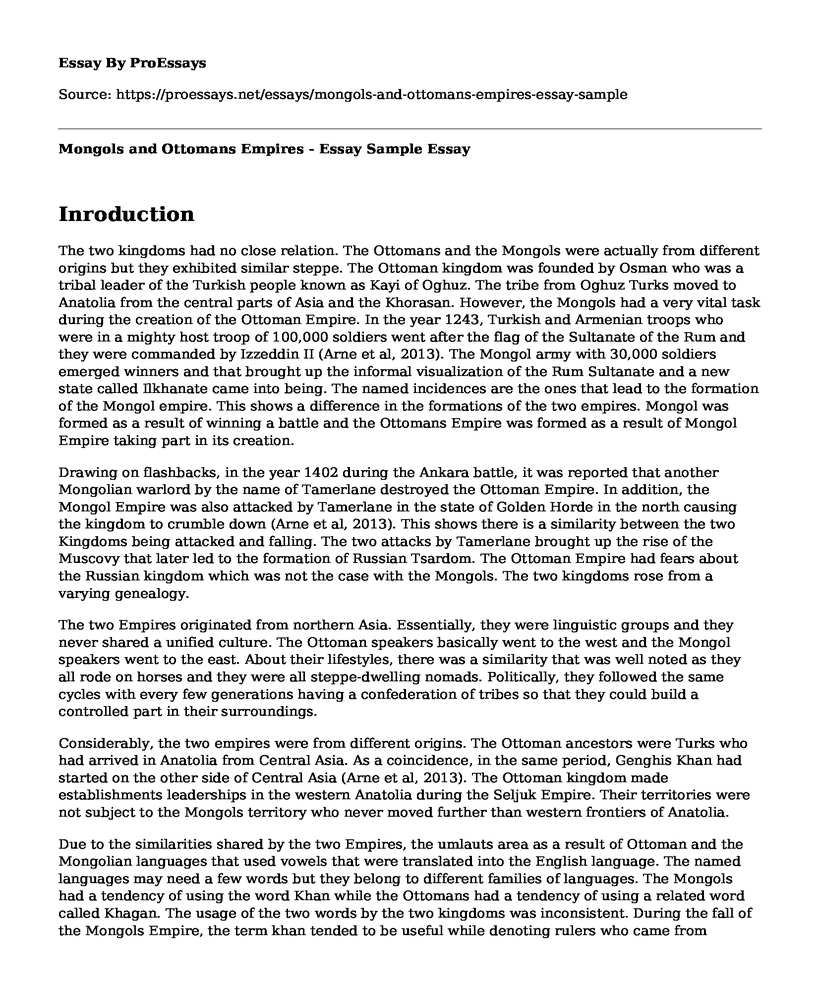Inroduction
The two kingdoms had no close relation. The Ottomans and the Mongols were actually from different origins but they exhibited similar steppe. The Ottoman kingdom was founded by Osman who was a tribal leader of the Turkish people known as Kayi of Oghuz. The tribe from Oghuz Turks moved to Anatolia from the central parts of Asia and the Khorasan. However, the Mongols had a very vital task during the creation of the Ottoman Empire. In the year 1243, Turkish and Armenian troops who were in a mighty host troop of 100,000 soldiers went after the flag of the Sultanate of the Rum and they were commanded by Izzeddin II (Arne et al, 2013). The Mongol army with 30,000 soldiers emerged winners and that brought up the informal visualization of the Rum Sultanate and a new state called Ilkhanate came into being. The named incidences are the ones that lead to the formation of the Mongol empire. This shows a difference in the formations of the two empires. Mongol was formed as a result of winning a battle and the Ottomans Empire was formed as a result of Mongol Empire taking part in its creation.
Drawing on flashbacks, in the year 1402 during the Ankara battle, it was reported that another Mongolian warlord by the name of Tamerlane destroyed the Ottoman Empire. In addition, the Mongol Empire was also attacked by Tamerlane in the state of Golden Horde in the north causing the kingdom to crumble down (Arne et al, 2013). This shows there is a similarity between the two Kingdoms being attacked and falling. The two attacks by Tamerlane brought up the rise of the Muscovy that later led to the formation of Russian Tsardom. The Ottoman Empire had fears about the Russian kingdom which was not the case with the Mongols. The two kingdoms rose from a varying genealogy.
The two Empires originated from northern Asia. Essentially, they were linguistic groups and they never shared a unified culture. The Ottoman speakers basically went to the west and the Mongol speakers went to the east. About their lifestyles, there was a similarity that was well noted as they all rode on horses and they were all steppe-dwelling nomads. Politically, they followed the same cycles with every few generations having a confederation of tribes so that they could build a controlled part in their surroundings.
Considerably, the two empires were from different origins. The Ottoman ancestors were Turks who had arrived in Anatolia from Central Asia. As a coincidence, in the same period, Genghis Khan had started on the other side of Central Asia (Arne et al, 2013). The Ottoman kingdom made establishments leaderships in the western Anatolia during the Seljuk Empire. Their territories were not subject to the Mongols territory who never moved further than western frontiers of Anatolia.
Due to the similarities shared by the two Empires, the umlauts area as a result of Ottoman and the Mongolian languages that used vowels that were translated into the English language. The named languages may need a few words but they belong to different families of languages. The Mongols had a tendency of using the word Khan while the Ottomans had a tendency of using a related word called Khagan. The usage of the two words by the two kingdoms was inconsistent. During the fall of the Mongols Empire, the term khan tended to be useful while denoting rulers who came from Genghis's lineage but the Ottomans never had that particular memory.
Work Cited
Roberts, John Morris, and Odd Arne Westad. The history of the world. Oxford University Press, USA, 2013.
Cite this page
Mongols and Ottomans Empires - Essay Sample. (2022, Dec 17). Retrieved from https://proessays.net/essays/mongols-and-ottomans-empires-essay-sample
If you are the original author of this essay and no longer wish to have it published on the ProEssays website, please click below to request its removal:
- A Review of Who Freed The Slaves? The Fight Over the Thirteenth Amendment
- Does Inequality Makes Deliberative Democracy Impossible? Essay
- The Classical Age of World History (500BCE-500CE): Greece, China and India Essay
- Essay Sample on The Role of U.S Government on Economy in Employment
- Essay Sample on The Bill of Rights: Protecting Human Rights in Constitutions
- U.S Transformed to Powerful Country: Equity, Control, Freedom - Essay Sample
- Essay on Life inside the Cape Coast Castle







